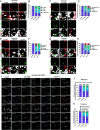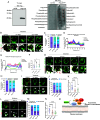Fig. 1.
Arf1 and Sec71 are required for asymmetric protein localization in neuroblasts. (A) Metaphase neuroblasts of control, UAS-arf1 RNAi, and UAS-sec71 RNAi. (A′) Quantification of aPKC localization in metaphase neuroblasts for (A). Control, Strong crescent = 100%, n = 56; arf1 RNAi, Strong crescent = 41%, Weak crescent = 33.4%, Absent = 17.9%, Cytoplasmic = 7.7%, n = 40; sec71 RNAi, Strong crescent = 50%, Weak crescent = 31.4%, Absent = 8.8%, Cytoplasmic = 7.1%, Cortical = 2.7%, n = 70. (B) Metaphase neuroblasts of control, UAS-Arf1T31N, and UAS-Sec71DN. (B′) Quantification of aPKC localization in metaphase neuroblasts for (B). Control, Strong crescent = 100%, n = 45; Arf1T31N, Strong crescent = 53.4%, Weak crescent = 31.1%, Absent = 2.2%, Cytoplasmic = 13.3%, n = 45; Sec71DN, Strong crescent = 30.2%, Weak crescent = 39.5%, Absent = 11.6%, Cytoplasmic = 14%, Cortical = 4.7%, n = 43. (C) Metaphase neuroblasts of control, UAS-arf1 RNAi, and UAS-sec71 RNAi. (C′) Quantification of Mira localization in metaphase neuroblasts for (C). Control, Strong crescent=100%, n = 56; arf1 RNAi, Strong crescent = 33.3%, Weak crescent = 41%, Absent = 7.7%, Cytoplasmic = 10.3%, Cortical = 7.7%, n = 40; sec71 RNAi, Strong crescent = 30%, Weak crescent = 40%, Absent = 20%, Cytoplasmic = 4.3%, Basal + Lateral = 5.7%, n = 70. (D) Metaphase neuroblasts of control, UAS-Arf1T31N, and UAS-Sec71DN. (D′) Quantification of Mira localization in metaphase neuroblasts for (D). Control, Strong crescent = 100%, n = 45; Arf1T31N, Strong crescent = 40%, Weak crescent = 33.3%, Absent = 26.7%, n = 45; Sec71DN, Strong crescent = 34.8%, Weak crescent = 28%, Absent = 18.6%, Cytoplasmic = 18.6%, n = 43. (E) Metaphase neuroblasts of control and UAS-arf1 RNAi. (E′) Quantification of Baz localization in metaphase neuroblasts for (E). Control, Strong crescent = 100%, n = 53; arf1 RNAi, Strong crescent = 41.7%, Weak crescent = 31.3%, Absent = 20.8%, Apical+Lateral = 6.2%, n = 48. (F) Metaphase neuroblasts of control and UAS-arf1 RNAi. (F′) Quantification of Par6 localization in metaphase neuroblasts for (F). Control, Strong crescent = 100%, n = 42; arf1 RNAi, Strong crescent = 51.2%, Weak crescent = 26.8%, Absent = 2.5%, Cytoplasmic = 19.5%, n = 41. (G) Metaphase neuroblasts of control and UAS-arf1 RNAi. (G′) Quantification of Gαi localization in metaphase neuroblasts for (G). Control, Strong crescent = 100%, n = 32; arf1 RNAi, Strong crescent = 52.8%, Weak crescent = 30.6%, Absent = 5.5%, Cytoplasmic = 11.1%, n = 36. (H) Metaphase neuroblasts of Control and UAS-Sec71DN. (H′) Quantification of Baz localization in metaphase neuroblasts for (H). Control, Strong crescent = 100%, n = 41; Sec71DN, Strong crescent = 42.2%, Weak crescent = 35.6%, Absent = 22.2%, n = 45. (I) Metaphase neuroblasts of control and UAS-Sec71DN driven by insc-Gal4, tub -Gal80ts were labeled with Par6 (red) and DNA (gray). (I′) Quantification of Par6 localization in metaphase neuroblasts for (I). Control, Strong crescent = 100%, n = 31; Sec71DN, Strong crescent = 47.3%, Weak crescent = 23.7%, Absent = 7.9%, Cytoplasmic = 21.1%, n = 38. (J) Metaphase neuroblasts of control and UAS-Sec71DN. (J′) Quantification of Gαi localization in metaphase neuroblasts for (J). Control, Strong crescent = 100%, n = 32; Sec71DN, Strong crescent=51.3%, Weak crescent = 25.6%, Disorganized = 7.7%, Cytoplasmic = 15.4%, n = 39. (K) Metaphase neuroblasts of control and UAS-arf1 RNAi. (K′) Quantification of Insc localization in metaphase neuroblasts for (K). Control, Strong crescent = 100%, n = 35; arf1 RNAi, Strong crescent = 52.4%, Weak crescent = 21.4%, Absent = 9.5%, Cytoplasmic = 16.7%, n = 42. (L) Metaphase neuroblasts of control and UAS-arf1 RNAi. (L′) Quantification of Numb localization in metaphase neuroblasts for (L). Control, Strong crescent = 100%, n = 32; arf1 RNAi, Strong crescent = 40.7%, Weak crescent = 28.1%, Absent = 15.6%, Cytoplasmic = 15.6%, n = 32. (M) Metaphase neuroblasts of control and UAS-Sec71DN. (M′) Quantification of Insc localization in metaphase neuroblasts for (M). Control, Strong crescent = 100%, n = 30; Sec71DN, Strong crescent = 52.6%, Weak crescent = 18.4%, Absent = 13.2%, Cytoplasmic = 15.8%, n = 38. (N) Metaphase neuroblasts of control and UAS-Sec71DN. (N′) Quantification of Numb localization in metaphase neuroblasts for (N). Control, Strong crescent = 100%, n = 25; Sec71DN, Strong crescent = 33.3%, Weak crescent = 26.7%, Absent = 13.3%, Cytoplasmic = 23.3%, Basal+Lateral = 3.3%, n = 30. Knockdown of arf1 and sec71 RNAi driven by insc-Gal4. Overexpression of Arf1T31N and Sec71DN driven by insc-Gal4, tub-Gal80ts. The means of analyzed phenotypes are shown within each column. (Scale bars, 5 µm.)





